Apart from the goods they carry, delivery trucks bring nothing positive to urban areas. The majority burn diesel or gasoline, and drivers often leave the engines running while making deliveries, exacerbating air pollution.
When these vehicles block the street, they delay other road users, causing frustration as well as yet more carbon dioxide to enter the atmosphere. By occupying sidewalks and creating blind spots, they increase the risk of accidents, especially for those on foot. If local governments do designate loading/unloading zones, typically they reduce the space available for pedestrians and cyclists. What’s more, trucks are noisy.
But it doesn’t have to be this way. An intriguing experiment in Taoyuan’s Dasi District (大溪) suggests that, when government entities cooperate with NGOs and private businesses, it’s possible to alleviate these negative externalities.

Photo: Lu Yun-fung, Taipei Times
Dasi’s Low Carbon and Quiet Consolidation Center (LCQCC) project recognized that, within conventional delivery ecosystems, there’s a vast amount of duplication. In busy neighborhoods, it’s not unusual to see a vehicle drop off a package at one address, then, a short time later, see another approach from the same direction and deliver something to the building next door. The center, the first of its kind in Taiwan, aimed to lessen the environmental footprint of the final stage of the manufacturer-to-consumer journey.
In a recent white paper published by the World Economic Forum (WEF), researchers noted that the rapid growth of e-commerce has led to a surge in the number of delivery vehicles on urban roads, and that “[under] a business-as-usual scenario, carbon emissions from all urban delivery traffic could increase by 60 percent by 2030…[the] urgent need to transition to zero-emission fleets and shared infrastructure is evident.”
In Taiwan, a delivery truck making a stop on its regular rounds may well save the deliveree a 10-km round trip. Because some people get around by car or motorcycle, while others use public transportation, it’s hard to say if e-commerce adds to or reduces the overall environmental cost of our shopping habits — even when ignoring associated issues like excessive packaging. But whether it does or it doesn’t, there’s no good reason why logistics companies shouldn’t be pushed to make their operations as sustainable as possible.

Photo: Lu Yun-fung, Taipei Times
THE LAND QUESTION
The LCQCC initiative was launched in December 2020 as one of five eco-logistics demonstration areas proposed by the Taoyuan City Government. A parking lot 400m south of Heping Road (和平路) and the town’s touristy old quarter was converted into a facility where goods from outside the area were transferred from conventional trucks to vehicles more appropriate to a crowded urban environment. In this case, electric three-wheelers were used for the “last mile.”
Urban Consolidation Centers (UCCs), as they’re known, are nothing new. According to a July 2012 paper in Transport Reviews, more than 100 were set up in 17 countries over the previous 40 years. Some have been a success, it seems: in Monaco, the amount of kerbside space occupied by delivery vehicles fell by 42 percent after a UCC was introduced.

Photo: Chen En-hui, Taipei Times
As the WEF paper points out, real estate shortages often make creating a UCC very difficult. In addition to having enough space so trucks can unload, such facilities need electric-vehicle charging points and storage for goods awaiting delivery or pickup.
Given the crowded character of Taiwan’s urban areas, it wasn’t surprising that land issues led to the termination of the LCQCC experiment. As reported in the April 9, 2023 issue of the Liberty Times, the Chinese-language sister newspaper of the Taipei Times, a lack of parking spots in the heart of Daxi caused a backlash against the consolidation center. A few months after that report, the LCQCC was dismantled and the site became a parking lot once again.
A recent academic paper examining the LCQCC, “Advancing Sustainable Last-Mile Delivery with Collaborative Governance: Lessons from Daxi’s Low Carbon and Quiet
Consolidation Center” (Urban Policy and Research, March 3) notes that Taiwan’s logistics industry has enjoyed rapid growth in recent years, but “the absence of a national or local logistics plan addressing the industry’s sustainability is a significant gap that needs to be filled.”
The paper, authored by a team at National Cheng Kung University’s (NCKU) Department of Transportation and Communication Management Science, points out that various aspects of the industry are overseen by the Ministry of Transportation and Communications, the Ministry of Economic Affairs and the Ministry of Finance. This “siloed approach,” it goes on to say, has resulted in an “unclear allocation of resources, budgeting and guidance, making it challenging to identify and address issues” and potential solutions.
The paper recounts how setting up the LCQCC required considerable grassroots engagement, including door-to-door visits, to develop partnerships and allay business owners’ concerns that the project would interrupt their operations. The city government appointed the Takoham Environmental Sustainability Foundation (財團法人大嵙崁環境永續發展基金會) as the local coordinator. This Dasi-based entity can be described as a “government-organized NGO” or GONGO, as the initial impetus and funding came from the local government.
INADEQUATE PARTICIPATION
Kerry TJ Logistics, President Transnet and HCT Logistics — three of Taiwan’s four major last-mile delivery operators — joined the project. State-owned Chunghwa Post was the biggest but not the only holdout.
Explaining that last-mile delivery is often handled by smaller companies, the paper’s lead author tells the Taipei Times that the project would have been more successful if it had included all delivery operators. This would have created “a level playing field,” says Cheng Tsu-jui (鄭祖睿), an NCKU assistant professor.
Using a GONGO to kick off the project was a good move, he adds, but “in the long run, the operation of a consolidation center should be transferred to a local business organization. From land-use perspectives, the center could have been a good opportunity to properly plan freight loading/unloading areas and low-emissions zones in Daxi, so as to double down on the benefits of the LCQCC.”
Cheng also noticed that the project suffered from a “discontinuation of political commitment” after Simon Chang (張善政) of the Chinese Nationalist Party (KMT) succeeded Cheng Wen-tsan (鄭文燦) of the Democratic Progressive Party (DPP) as Taoyuan’s mayor.
Elsewhere in Taiwan, NCKU’s Cheng thinks close-knit neighborhoods and business improvement districts might be suitable locations for consolidation centers.
Entrepreneurs who require deliveries or pickups multiple times each week are likely to support such initiatives, especially if they’re keen to improve the overall environment for their customers. Anping (安平) in Tainan, and neighborhoods where there’s potential for pedestrianization, might be good candidates, he says.
“But the challenge remains as to how last-mile delivery can be organized. Should shops pick up their own goods or should a local business association contract a logistics company to do it?” Cheng says.
Asked if any local governments have an especially forward-thinking approach to last-mile logistics, Cheng replies: “No, because of the fragmentation of freight transportation governance here. But Taiwan isn’t alone. Globally, few local governments have this capacity.”
However, he expresses some optimism, saying: “Now that the national government is planning low-emission zones, hopefully the issue of urban freight will soon be included in their discussions.”
Steven Crook, the author or co-author of four books about Taiwan, has been following environmental issues since he arrived in the country in 1991. He drives a hybrid and carries his own chopsticks. The views expressed here are his own.

April 14 to April 20 In March 1947, Sising Katadrepan urged the government to drop the “high mountain people” (高山族) designation for Indigenous Taiwanese and refer to them as “Taiwan people” (台灣族). He considered the term derogatory, arguing that it made them sound like animals. The Taiwan Provincial Government agreed to stop using the term, stating that Indigenous Taiwanese suffered all sorts of discrimination and oppression under the Japanese and were forced to live in the mountains as outsiders to society. Now, under the new regime, they would be seen as equals, thus they should be henceforth

Last week, the the National Immigration Agency (NIA) told the legislature that more than 10,000 naturalized Taiwanese citizens from the People’s Republic of China (PRC) risked having their citizenship revoked if they failed to provide proof that they had renounced their Chinese household registration within the next three months. Renunciation is required under the Act Governing Relations Between the People of the Taiwan Area and the Mainland Area (臺灣地區與大陸地區人民關係條例), as amended in 2004, though it was only a legal requirement after 2000. Prior to that, it had been only an administrative requirement since the Nationality Act (國籍法) was established in

With over 80 works on display, this is Louise Bourgeois’ first solo show in Taiwan. Visitors are invited to traverse her world of love and hate, vengeance and acceptance, trauma and reconciliation. Dominating the entrance, the nine-foot-tall Crouching Spider (2003) greets visitors. The creature looms behind the glass facade, symbolic protector and gatekeeper to the intimate journey ahead. Bourgeois, best known for her giant spider sculptures, is one of the most influential artist of the twentieth century. Blending vulnerability and defiance through themes of sexuality, trauma and identity, her work reshaped the landscape of contemporary art with fearless honesty. “People are influenced by

The remains of this Japanese-era trail designed to protect the camphor industry make for a scenic day-hike, a fascinating overnight hike or a challenging multi-day adventure Maolin District (茂林) in Kaohsiung is well known for beautiful roadside scenery, waterfalls, the annual butterfly migration and indigenous culture. A lesser known but worthwhile destination here lies along the very top of the valley: the Liugui Security Path (六龜警備道). This relic of the Japanese era once isolated the Maolin valley from the outside world but now serves to draw tourists in. The path originally ran for about 50km, but not all of this trail is still easily walkable. The nicest section for a simple day hike is the heavily trafficked southern section above Maolin and Wanshan (萬山) villages. Remains of